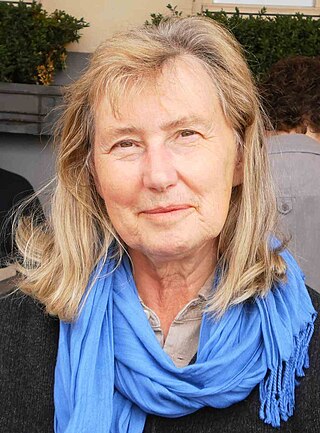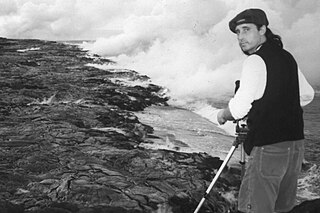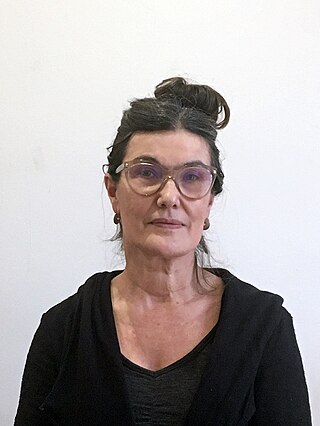Video art is an art form which relies on using video technology as a visual and audio medium. Video art emerged during the late 1960s as new consumer video technology such as video tape recorders became available outside corporate broadcasting. Video art can take many forms: recordings that are broadcast; installations viewed in galleries or museums; works either streamed online, or distributed as video tapes, or on DVDs; and performances which may incorporate one or more television sets, video monitors, and projections, displaying live or recorded images and sounds.

Kutluğ Ataman is an acclaimed Turkish-American contemporary artist and feature filmmaker. Ataman's films are known for their strong characterization and humanity. His early art works examine the ways in which people and communities create and rewrite their identities through self-expression, blurring the line between reality and fiction. His later works focus on history and geography as man-made constructs. He won the Carnegie Prize for his works Kuba in 2004. In the same year he was nominated for Turner Prize for his work Twelve.

The University for the Creative Arts is a specialist art and design university in the south of England.
Scratch video was a British video art movement that emerged in the early to mid-1980s. It was characterised by the use of found footage, fast cutting, and multi-layered rhythms. As a form of outsider art, it challenged many of the establishment assumptions of broadcast television, as well of those of gallery-bound video art.
Adam Chodzko is a contemporary British artist, exhibiting internationally. His practice uses a wide range of media, including video, installation, photography, drawing, and performance.

Max Hattler is a German video artist and experimental filmmaker. He created the kaleidoscopic political short films "Collision" (2005) and "Spin" (2010), abstract stop motion works "Shift" (2012) and "AANAATT" (2008), and psychedelic animation loops "Sync", "1923 aka Heaven" and "1925 aka Hell" (2010).

Andrew Kötting is a British artist, writer, and filmmaker.
Gregor Muir is Director of Collection, International Art, at Tate, having previously been the Executive Director of the Institute of Contemporary Arts in London from 2011 until 2016. He was the director of Hauser & Wirth, London, at 196a Piccadilly, from 2004 - 2011. He is also the author of a 2009 memoir in which he recounts his direct experience of the YBA art scene in 1990s London.
Marc Lafia is a multidisciplinary artist, filmmaker, photographer, writer, educator, and information architect. He is known for his contributions to the intersection of art, technology, and temporality. Lafia’s works explore computation and the impact of network culture on media, communication, and the self.
Semiconductor is UK artist duo Ruth Jarman and Joe Gerhardt. They have been working together for over twenty years producing visually and intellectually engaging moving image works which explore the material nature of our world and how we experience it through the lens of science and technology, questioning how these devices mediate our experiences. Their unique approach has won them many awards, commissions and prestigious fellowships including; SónarPLANTA 2016 commission, Collide @ CERN Ars Electronica Award 2015, Jerwood Open Forest 2015 and Samsung Art + Prize 2012. Exhibitions and screenings include; The Universe and Art, Mori Art Museum, Tokyo, Japan, 2016; Infosphere, ZKM, Karlsruhe, 2016; Quantum of Disorder, Museum Haus Konstruktiv, Zurich, 2015; Da Vinci: Shaping the Future, ArtScience Museum, Singapore, 2014; Let There Be Light, House of Electronic Arts, Basel 2013 ; Field Conditions, San Francisco Museum of Modern Art, 2012; International Film Festival Rotterdam, 2012; New York Film Festival: Views from the Avant Garde, 2012; European Media Art Festival, 2012; Worlds in the Making, FACT, Liverpool 2011 ; Earth; Art of a Changing World, Royal Academy of Arts, London, 2009 and Sundance Film Festival, 2009.
Tom Corby and Gavin Baily (1970) are two London based artists who work collaboratively using public domain data, climate models, satellite imagery and the Internet. Recent work has focused on climate change and its relationship to technology and has involved collaborations with scientists working at the British Antarctic Survey. Corby and Baily are founder members of the Atmospheric Research Collective, an experimental artist group which works in collaboration with climate scientists. For an overview of recent works see "An interview with artist and writer Tom Corb y".

Else Madelon Hooykaas is a Dutch video artist, photographer and film maker. She makes films, sculptures, audio-video installations and has published several books.
Aldo Tambellini was an Italian-American artist. He pioneered electronic intermedia, and was a painter, sculptor, and poet. He died at age 90, in November 2020.

The imai Foundation was founded in 2006 as imai - inter media art institute. It is an institution dedicated to the preservation, research and distribution of video art and media art and associated activities. The foundation organizes workshops, conferences, screenings, exhibitions, research projects and case studies concerning the current questions of conservation and restoration of media art. It aims to develop further the possibilities of (digital) preservation, presentation and distribution of media art.
Oreet Ashery is an interdisciplinary artist based in London.
Sarah Pucill is a London-based film artist. Her work is distributed by LUX, London and LightCone, Paris. She is a Reader at University of Westminster. Central to her work is "a concern with mortality and the materiality of the filmmaking process". Much of her work appears within the restrictions of domestic spaces. In her "explorations of the animate and inanimate, her work probes a journey between mirror and surface".
Gina Czarnecki is a British artist. Her art spans a variety of mediums, including film, sculpture, installation art, and video and is frequently informed by biomedical science. She is the daughter of a Polish father and an English mother. Czarnecki currently resides in Liverpool, England.

Kent Tate is a Canadian artist and filmmaker living in British Columbia. Tate is known for his single-channel video installation works.

Emmanuelle Waeckerlé is an experimental musician, multidisciplinary artist and composer based in London. Her text scores, publications, and performances explore the materiality and musicality of language while proposing playful encounters with our "interior or exterior landscape and each other."







